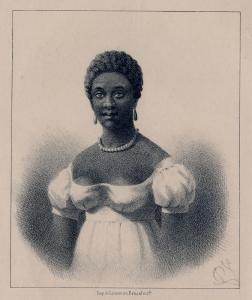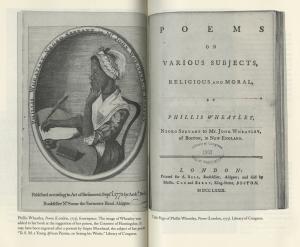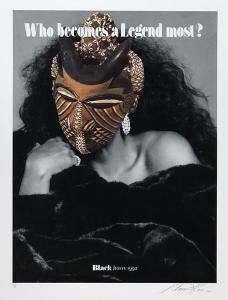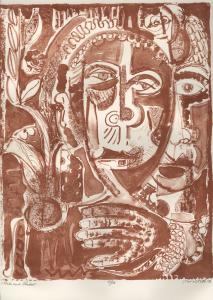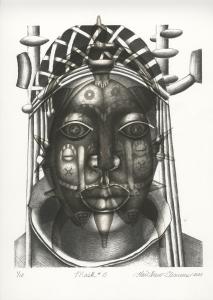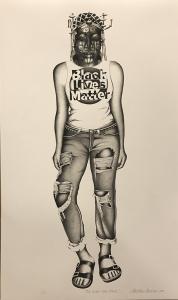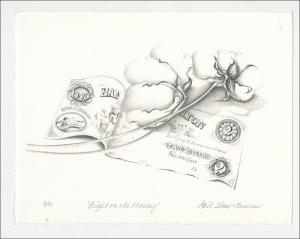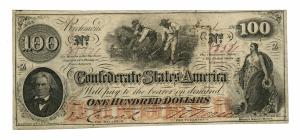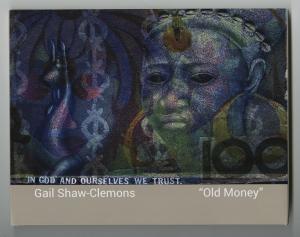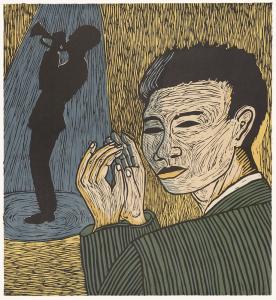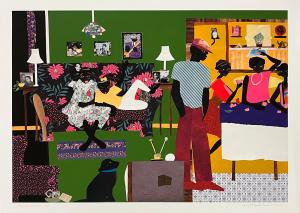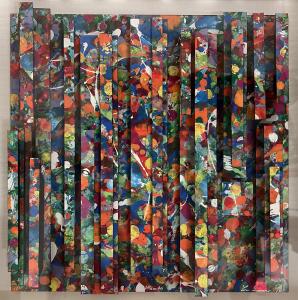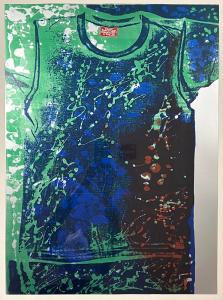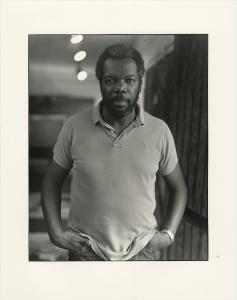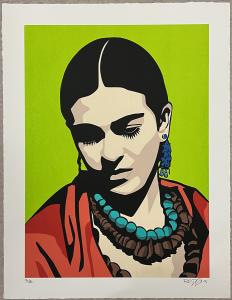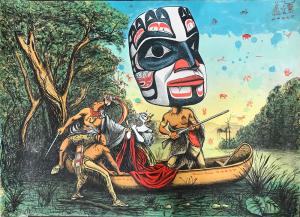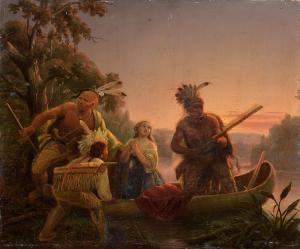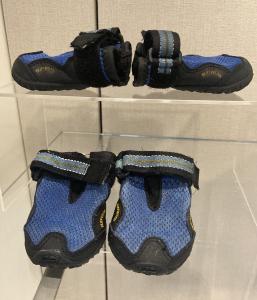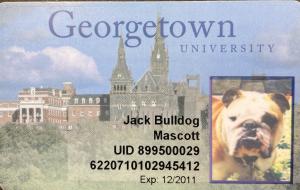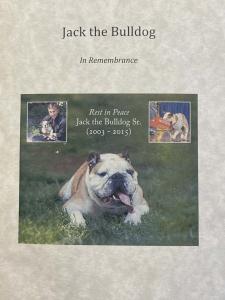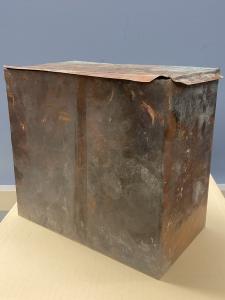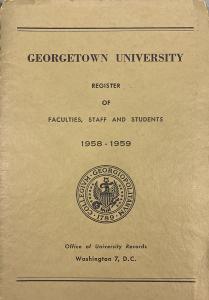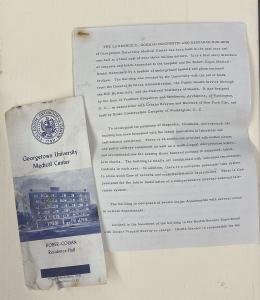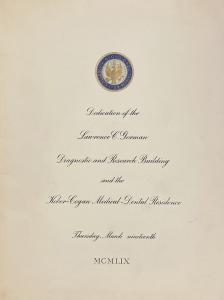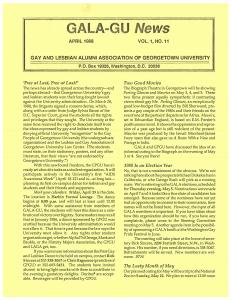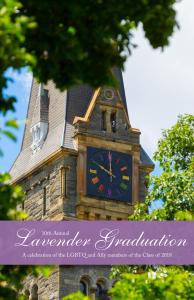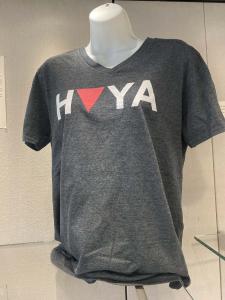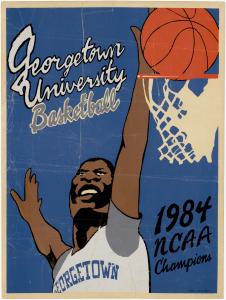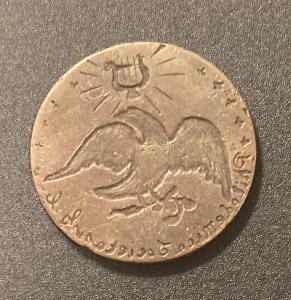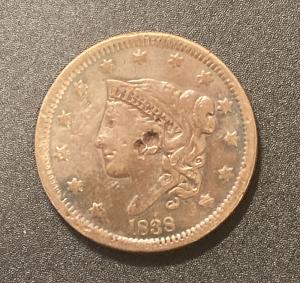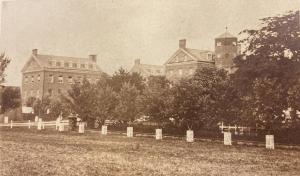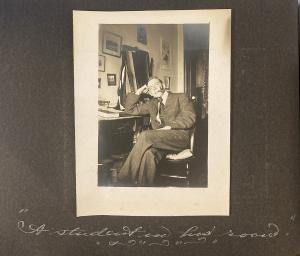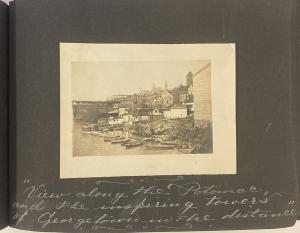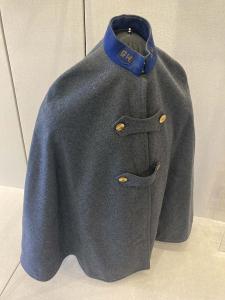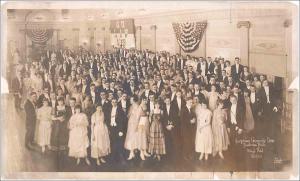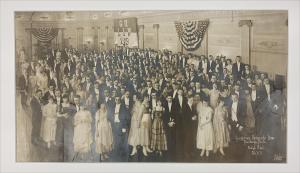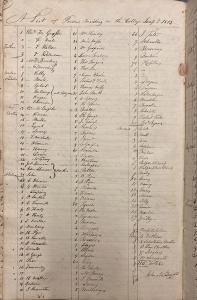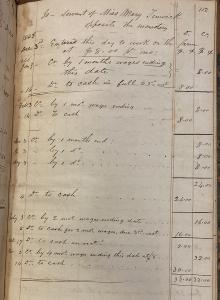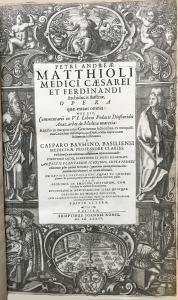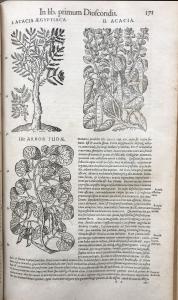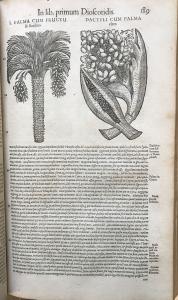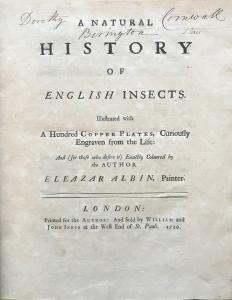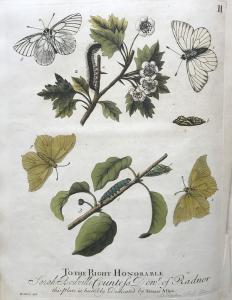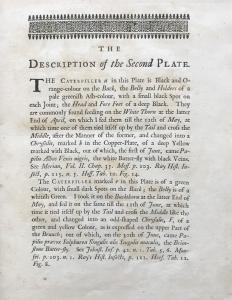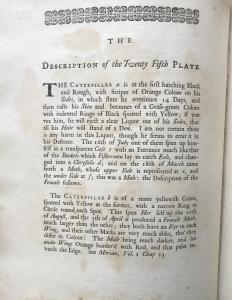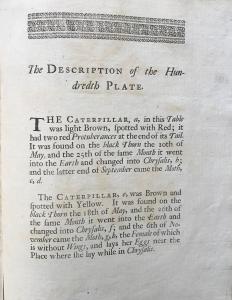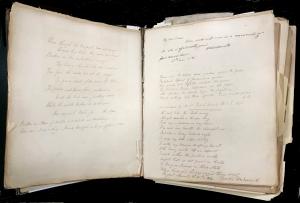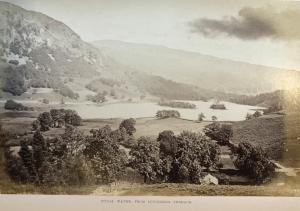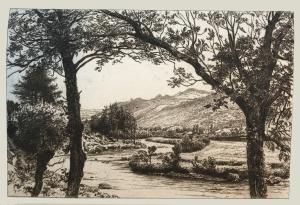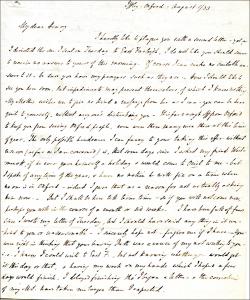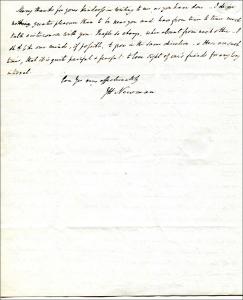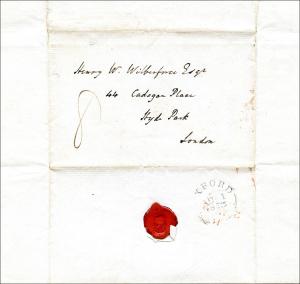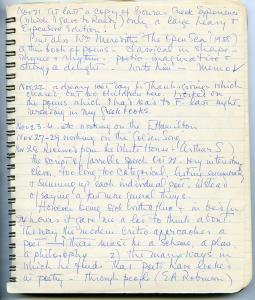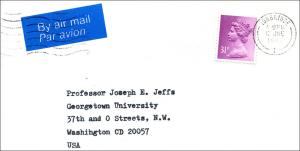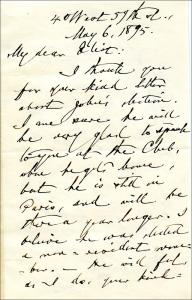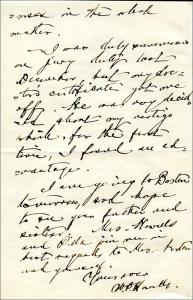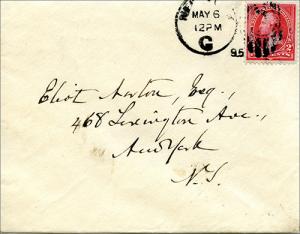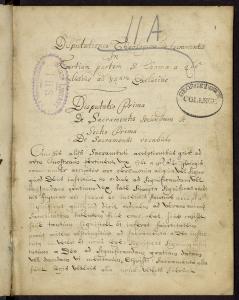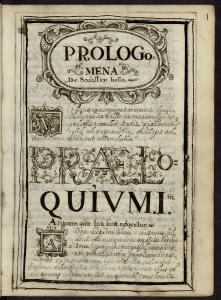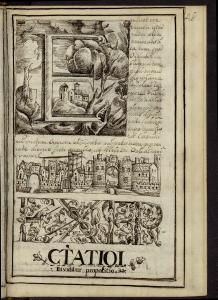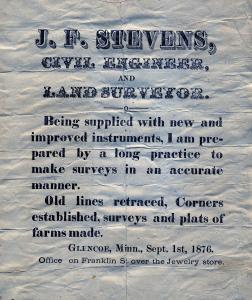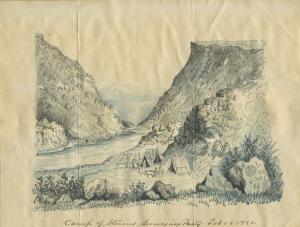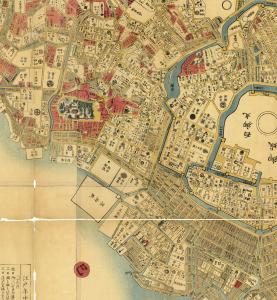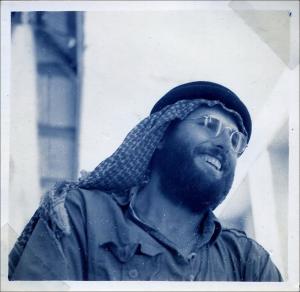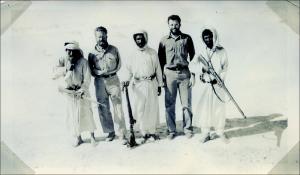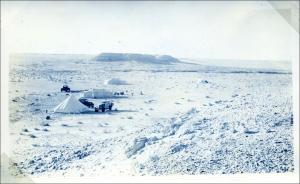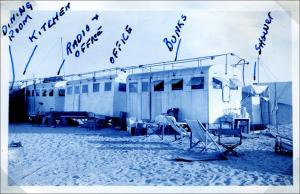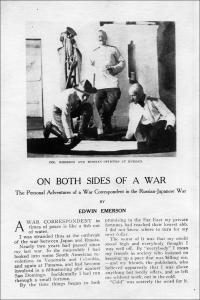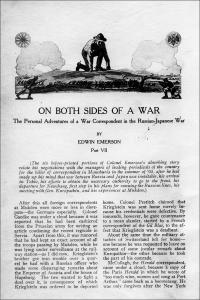Recent Acquisitions and Favorites in the Booth Family Center for Special Collections
Recent Acquisitions from the University Art Collection
The art collection has sought to expand its holdings of art by minority and under-represented artists. Another collecting focus has been on women artists and artists native to the Washington, D.C. area. The artworks displayed here represent recent purchases and donations. Some of them were created in response to the police killings of Ahmaud Arbery, Breonna Taylor, George Floyd and other Black Americans in the spring of 2020 and beyond, and the growth of the Black Lives Matter movement.
One can determine the year of acquisition by the first four digits of the object’s accession number, found on the accompanying wall text. Additional acquisitions from this collecting initiative were too large to accommodate on one wall. We look forward to sharing more of them online and in future exhibitions. We are thrilled and honored to present these powerful and inspiring artworks by some of the country's leading contemporary artists.
Phillis Wheatley
Bénard et Cie, lithographer
from the book Revue des Colonies
Paris: Imprimerie Lemercier et cie, 1834-1842
Fairchild Endowment Fund purchase
2020.1.1
This French lithograph is one of only two accepted portraits of Phillis Wheatley, acclaimed as the first published poet of African heritage. An engraving in profile was printed in her 1773 book of poems, published in London, while this image is likely posthumous. The Vincent Carretta book below is included to show Wheatley's 18th century portrait.
Phillis Wheatley: biography of a genius in bondage
Carretta, Vincent
Athens, GA: University of Georgia Press, 2011
Sea Wives
from the 1904-05 series
Zoë Charlton
2015
Collage with stickers on paper
Fairchild Endowment Fund purchase
2021.7.1
Zoë Charlton is a Baltimore artist on the art faculty at American University. She was recently invited to create a mural painting in the stairwell of the Phillips Collection. This unique collage made with stickers is from a series on the theme of travel and conveys feelings of cultural and social displacement. The images in the series playfully juxtapose cultural artifacts with women travelers in Victorian clothing, often in incongruous arrangements.
Blackglam Legends: Black Jessye 1992
from the African Diva Project
Margaret Rose Vendryes
2019
(incorporating a 1992 photograph likely by Rocco Laspata)
Archival pigment print on paper
2/5
Fairchild Endowment Fund purchase
2020.3.1
For over a decade Margaret Rose Vendryes has worked on her African Diva Project, which links African American celebrities to their African roots by depicting them wearing traditional African masks. Her unusual combination of Western and African aesthetics creates a dynamic juxtaposition of form and content. She created a series based on the popular 1990s fashion advertisements for Blackglama mink that featured eight celebrities of African descent. In her re-interpretation of the advertisement, Vendryes imposed an African tribal mask over the face of opera diva Jessye Norman.
Mask and Shadow
David Clyde Driskell
2009
Lithograph on paper
21/36
Gift of Carol Harrison
2016.27.1
David Driskell studied art at Howard University and took several trips to the African continent, from 1969 to 1972, which had a lasting impact on his work. He became inspired by traditional African artforms that served as symbolic links to his African and American ancestors. Thus, masks became a central theme in much of his work.
Driskell was also an important scholar and curator who pioneered the study of African American Art with his pivotal exhibition, Two Centuries of Black American Art, at the Los Angeles County Museum of Art in 1976. That year he began teaching at the University of Maryland, where he was named the Distinguished University Professor of Art in 1995. At Maryland, he established The David C. Driskell Center for the Study of Visual Arts and Culture of African Americans and the African Diaspora which maintains his archive of research materials and artifacts. Driskell died at the age of 89 on April 1, 2020, due to complications from COVID-19.
David Driskell
Carol Harrison
Undated (20th century)
Gelatin silver print
Along with a self-published mini photo book
Gift of the artist
2016.27.46
Harrison’s body of work focuses on people in the arts, particularly in Washington, DC, such as artists, curators, and museum directors. In 2016 Harrison donated a large number of her portraits to Georgetown, including many images of DC artists and also public figures in major events on Georgetown’s campus.
Mask #0 and We Wear the Mask (Female)
Gail Shaw-Clemons
Mask #0
2021
Lithograph with chine-collé on paper
1/10
We Wear the Mask (Female)
2020
Archival pigment print on paper
1/10
Fairchild Endowment Fund purchase
2021.5.4 and 2021.5.1
Gail Shaw-Clemons creates fine print editions at Pyramid Atlantic in Hyattsville, Maryland and the Robert Blackburn Studio in New York. She is fascinated with West African tribal masks and has produced a series of lithographs blending human faces with these iconic forms. As the artist has explained, “I thought about the mask as embodying the spirit of my ancestors as protectors, with that in mind, I began to envision the mask as transparent in order to achieve a spiritual effect.”
In the larger print, a female figure wears the mask that is shown in the accompanying lithograph. This work was inspired by the celebrated 1895 poem by Paul Laurence Dunbar of the same title. According to the artist, the poem addressed “the metaphorical ‘mask’ of happiness and contentment that African Americans were forced to wear in front of white society while struggling under racism and segregation.”
Right on the Money
Gail Shaw-Clemons
2011
Lithograph on paper
2/10
Fairchild Endowment Fund purchase
2021.5.2
Shown with:
Confederate Banknote
Unknown (American)
1862
Engraving on paper
Transfer from the University Archives
This lithograph was created in response to designs on Confederate banknotes. It is shown with an authentic one hundred dollar Confederate banknote in the collection. Antebellum paper currency featured images of enslaved people picking cotton and performing other arduous manual labor. Shaw-Clemons paired her drawing of a banknote with a stem of cotton because “money was actually made from cotton in the physical sense as well as economically.”
Old Money
Gail Shaw-Clemons
2016
Commercial/offset printing on paper
Fairchild Endowment Fund purchase
2021.5.3
This book reproduces drawings, collages and other artworks inspired by out-of-date African paper currency. Through her study and contemplation of the currency, Shaw-Clemons came to realize “the contributions of my African ancestors had a direct part in creating the first millionaires in America.”
Negro Drawings
Miguel Covarrubias
London and New York: Alfred A. Knopf, 1927
Art Collection purchase
2016.45.1
Miguel Covarrubias was a successful Mexican artist and ethnographer who revolved among the fashionable art and theater circles of New York City. This volume is devoted to the wildly popular musicians and dancers in the jazz clubs of Harlem. Several of the drawings were published in Vanity Fair magazine in 1925.
Hepcat
from the Copacetic series
Alison Saar
2019
Linocut on Japanese handmade kozo paper
17/20
Fairchild Endowment Fund purchase
2020.26.1
Alison Saar is an acclaimed multimedia artist from Los Angeles whose work focuses on issues of Black female identity and the history of the African diaspora. This stylized print is from a suite of eight linocuts called Copacetic. The images of performers and patrons in a nightclub are inspired by figures of the Harlem Renaissance. Copacetic is based on a stained glass installation that Saar created for the 125th Street subway station in Harlem.
Mom on Seneca
Judy Bowman
2021
Archival pigment print on paper
10/25
Fairchild Endowment Fund purchase
2021.3.1
Judy Bowman uses figurative collage to convey autobiographical narratives. While a student majoring in art at Morris Brown College and Clark Atlanta University, Bowman was selected to contribute to the decoration of the MLK Library at the Interdenominational Theological Center. During that time she was privileged to meet Coretta Scott King and Alberta King, the widow and mother of Martin Luther King, Jr., which had a formative impact on her career.
Mom on Seneca depicts Bowman’s childhood home on the Eastside of Detroit in the 1960s. As she recalled, “It was not rare to see the adults enjoying a lively game of cards, while us kids were off watching television and finding our own mischief in the den – a cultural scene in the fabric of many Black homes and traditions.”
Mambo
Luther McKinley Stovall
2010
Collage, silkscreen monoprint on paper
1/0
Fairchild Endowment Fund purchase
2011.31.1
Master printer Lou Stovall is a pivotal figure in the D.C. art community who for decades has printed silkscreen editions of other artists’ work, as well as his own, at his community studio Workshop, Inc. Stovall is revered for his vivid screenprints and his charitable support of the community through his art commissions. He created fine editions for political causes such as the Obama campaign in 2008 and the Democratic National Convention in 1988. Stovall has also served on the Arts Council of American University for over 35 years and shared his creative vision with generations of younger artists.
In the catalog to his 2012 exhibition at the Katzen Art Center, Stovall explained, “The gestures and colors of ink that I pour onto the screen and print on rag paper can never be recreated in exactly the same way; each impression is unique to the piece and each piece will go through many passes under the screen over a period of days, weeks or months.”
T-shirt - EEO
Sam Gilliam, artist
Luther McKinley Stovall, printer
1973
Screenprint/serigraph on paper
42/100
Art Collection purchase
2021.8.1
Sam Gilliam is a nationally and internationally recognized color field painter known for his draped canvases painted in vivid colors. After earning his M.A. in painting at the University of Louisville he moved to Washington, DC in 1962.
Lou Stovall printed a number of powerful silkscreen posters for various cultural events and organizations during the 1960s and 70s when the first mayor, Walter E. Washington, was appointed by President Johnson, and the DC Home Rule was enacted by Congress. This poster was commissioned by the Equal Employment Opportunity Commission. It was a creative collaboration between Gilliam and his friend Lou Stovall, whose work is displayed above. Gilliam decided to try something new, and used an actual t-shirt as the stencil for the image. He cleverly labeled the tag of the shirt with the commission’s monogram.
Sam Gilliam
Carol Harrison
Undated (20th century)
Gelatin silver print
Along with a self-published mini photo book
Gift of the artist
2016.27.135 and 2016.27.4
Young Frida (Green Version)
Raul Caracoza
2006
Screenprint/serigraph on paper
16/40
Fairchild Endowment Fund purchase
2021.6.1
Raul Caracoza is inspired by the Latino culture of his home in suburban Los Angeles. His recent works focus on Latino icons and musical figures. This colorful screenprint depicts the artist Frida Kahlo (1907-1954), who was married to the famous muralist Diego Rivera. She was known for her colorful clothing inspired by traditional Mexican dress that asserted her cross-cultural identity. Her work consists of compelling self-portraits in which she established her unique visual persona.
Detention at the Border of Language
Enrique Chagoya
2019
Lithograph on paper
5/30
Fairchild Endowment Fund purchase
2020.11.1
Shown with:
The Abduction of Daniel Boone’s Daughter by the Indians
Charles Ferdinand Wimar
1853
Reproduction of original oil on canvas
102 x 128 cm
Mildred Lane Kemper Art Museum, Washington University
Mexican-born Enrique Chagoya teaches art at Stanford University and his work incorporates cross-cultural iconography to comment on contemporary issues. In this print, Chagoya juxtaposes a Mayan ceremonial mask with a cartoon-like rendering of a 1853 painting by Karl Ferdinand Wimar entitled The Abduction of Daniel Boone’s Daughter. As explained by Chagoya, the work is a “…reminder that all nations in the Americas were created by undocumented immigrants from Europe. Today, some politicians call refugees from Central America and other countries ‘illegal aliens’ but for me they are no different from the Pilgrims or Daniel Boone’s daughter. Xenophobia goes against the spirit of this great country I immigrated to and adopted as my home when I became an American citizen.”
Selections from the Georgetown University Archives
The Georgetown University Archives houses records relating to all aspects of the University’s history and makes them available to faculty, students, and other researchers. Many of the records in the University Archives were transferred from campus offices; these are supplemented by generous donations of materials from alumni, faculty, staff, and friends of the University.
In addition to acquiring records, University Archives staff identify items in our collection in need of conservation treatment; we also collaborate with Lauinger Library’s Digital Services and Metadata Services staff on digitization projects which expand access to our holdings beyond those who are able to visit in person. Items in this case reflect these diverse aspects of our work.
Jack the Bulldog Collection
In 1962, Georgetown students set about bringing back the live mascot tradition on campus after it was discontinued in 1951 following the suspension of football as a varsity sport. A bulldog was chosen to represent the “tenacity” of the Georgetown athlete and, later that year, a two-year old English Bulldog was purchased. Students hoped to name the dog “Hoya” but the new dog would only respond to “Jack.” Jack has been an icon on campus ever since and, while each Jack is a little different, he can typically be found on a walk around campus or fiercely destroying boxes at basketball games.
The material on display here was collected by Christopher Steck, S.J., who was the official caretaker of the dog we know as “Jack, Sr.” Jack, Sr. served dutifully as mascot from 2003-2012 and is, to date, Georgetown’s longest serving bulldog mascot.
Items on display:
- “Four-Legged Legacy: New Mascot has Hoya Family History” by Greg Langlois, Blue & Gray, Volume 13 Issue 1, 2003-2004.
- Georgetown t-shirt and dog shoes worn by Jack, Sr.
- GoCard used by Jack, Sr.
- Memorial program for Jack, Sr., 2015
Transfer from Christopher Steck, S.J.
Kober-Cogan Building Copper Time Capsule and Contents
On April 5, 2018, the demolition of the Kober-Cogan Building on the south side of Georgetown’s medical campus began. Opened in 1959, Kober-Cogan originally served as a dormitory and in 1961 became the University’s first coed dorm. This copper box, placed behind the building’s cornerstone as a time capsule during its construction, was retrieved during the demolition process.
Records in the University Archives document that time capsules were placed in a number of other campus buildings including McDonough Gymnasium and Lauinger Library.
Transfer from the Archives of Capital Projects, Planning and Facilities Management
Kober-Cogan Demolition, 2018
Photograph by Bill Cessato, Senior Director of Communications and Strategic Initiatives for the School of Nursing and Health Studies, April 5, 2018
Transfer from Bill Cessato, Senior Director of Communications and Strategic Initiatives for the School of Nursing and Health Studies
LGBTQ Resource Center Archives
The founding of the LGBTQ Resource Center is a story of student activism. Following several hate crimes against LGBTQ students on campus in 2007, a coalition of student groups organized the Out for Change Campaign highlighting issues faced by Georgetown’s LGBTQ community. The group laid out demands for change, including the creation of a resource center with full-time staff, which were met by University administration. Georgetown’s LGBTQ Resource Center opened in the fall of 2008, helmed by its inaugural director Sivagami “Shiva” Subbaraman. In her 13 years as director, Subbaraman initiated a variety of programming to engage not only students, faculty, and staff but also Georgetown’s alumni community to build a safe and welcoming space for all to engage with and celebrate one another.
The records of the LGBTQ Resource Center highlight the work of the Center but also document the history of the LGBTQ community at Georgetown, dating back to the late 1970s. These records were donated to the Center by a multitude of alumni and allies who were involved in the early efforts by students to organize officially recognized student groups on the main campus and at the Law Center and the subsequent civil rights lawsuit filed against the University by these students.
Items on display:
- ”Georgetown first to recognize gays”, The Hoya, February 2, 1979
- GALA-GU News, April 1988
- Hoya Pride T-shirt
- OUTober 2017 Schedule of Events Poster
- Lavender Graduation 10th Anniversary Program, 2018
Transfer from Sivagami “Shiva” Subbaraman
Patrick Ewing Poster
Christian Simms (C'1984)
1984
Screen Print
This poster was designed and produced by Georgetown student Christian “Chris” Simms to commemorate the Georgetown men's basketball team’s 1984 NCAA championship win. Simms began creating posters that featured images of Georgetown’s campus during his sophomore year as a way to help pay for tuition. He later created the Ewing poster as his first sports-oriented piece. Prints of Simms’s work were sold on campus at the bookstore and at Saxa Sundries (Simms held the position of Director of Advertising for the Corp at the time).
Gift of Bennie Smith (C'1986)
Philodemic Society Seal, ca. 1838
In fall 1830, students organized a debate society which was subsequently named the Philodemic Society of Georgetown College. This seal, engraved in hollow relief, was designed to leave an impression in wax as a way of sealing or signing documents. Created on the reverse of a 1838 U.S. copper cent, it depicts an eagle holding what may be an olive branch, with the name of the Society around the perimeter.
Gift of Richard J. Cellini (C'1984, L'1988)
Campus, 1866 or earlier
Photograph by John Goldin & Co, No. 4, Market Space, Pa. Avenue, Washington, D.C.
This undated image may be the earliest known photograph of campus. Taken from the northeast, and the only early photograph of campus in the University Archives taken from that perspective, it shows Maguire Hall to the left and Old North to the right, with the roof line of Isaac Hawkins Hall also visible.
We can date this image to 1866 or earlier because in 1866, a new roof was put on the Old North (then simply the North Building) and its towers were remodeled and built up an additional 30 feet; this photograph shows the towers prior to their remodeling.
Gift of Richard J. Cellini (C'1984, L'1988)
“A Student in his room” and “View along the Potomac and the imposing towers of Georgetown in the distance”
Photograph album belonging to Charles Edward Kress (enrolled at Georgetown College, 1904-1906)
The album contains almost 100 images. A few show Kress’s hometown of Lancaster, PA, but the bulk relate to his time at Georgetown, giving delightful glimpses of student life at the turn of the last century, as well as views of campus and the surrounding area.
Gift of Steve Fernie
Georgetown University Hospital Nurse's Cape, ca. 1940, and images of Roena Graham Helms (Diploma 1935) in her nursing uniform, ca. 1940
Roena Graham Helms earned a diploma in Nursing in 1935 and continued to work at Georgetown University Hospital during World War II, retiring upon her marriage in 1945. In the image on the right, Helms is pictured in her student nurses’ uniform, which consisted of a blue and white striped dress that fell to the mid-calf with a large bib that went around the neck and a white apron that fell the entire length of the dress. Students also wore a white cap once they completed a probationary period.
The wool cape seen here was part of the standard uniform for Georgetown nursing students until at least 1968. It has the initials “G.H.” embroidered on the collar to signify Georgetown Hospital. In the image on the left, Helms can be seen wearing the typical uniform for practicing nurses.
Gift of Jo Anne Belle Yamaka
Documenting the COVID-19 Pandemic
The items on this shelf highlight the work done by Archives’ staff to capture historic moments in real-time; specifically the impact of the COVID-19 pandemic on the Georgetown community. Typically, material comes to the University Archives once it is no longer in active use, which usually happens many months and even years after the material was created. However, the impact of certain events, like the pandemic, compel Archivists to more immediately document these moments to ensure not only that a record is kept but also that a multitude of viewpoints are represented and that materials are contextualized accurately.
Items on display:
- Image of an empty Healy Lawn in March 2020 taken by Lynn Conway and submitted to the University Archives as part of the COVID-19 Memory Project
- Page from a student journal created in March 2020 and submitted to the University Archives as part of the COVID-19 Memory Project
- Archived tweets for the hashtag #hoyasathome. The hashtag was created by Georgetown Athletics so that fans could show their support for Georgetown’s athletes during the COVID-19 pandemic.
Law School Freshman Prom, Raleigh Hotel, February 16, 1917
This photograph was conserved in 2019. Conservators cleaned the surface to remove grime and tape residue, mended tears, and flattened it in a heat press. They then placed it in a custom mat of museum quality mat board to allow for safe display and research use.
“A List of Persons residing in the College, Jany. 1st, 1815.” Day Book, 1814-1817 (I.A.4.e)
and
Georgetown College Hires Jo [Edlen?] from Mary Fenwick, 1845. Various Accounts. Students, Workmen, Societies, October 1837-October 1846 (I.AA.1.h)
Much of the material in the University Archives documenting Georgetown College’s participation in slavery is found in volumes of the College’s late 18th- and early- to mid-19th century financial records. Entries scattered throughout these volumes document the names of enslaved people who labored on campus, describe the work they undertook, and record expenses for slave provisions such as clothing and medicine. The Georgetown University Library has begun a project to digitize these volumes and make them available to anyone, anywhere, who wants to access them. The first 24 volumes have been digitized and can be accessed through the DigitalGeorgetown website.
Shown here:
- the "List of Persons residing in the College, Jany. 1st 1815" recorded in the 1814-1817 day book. This includes the names of 17 servants (enslaved people).
- Georgetown College hires Jo, likely Joseph Edlen, from Mary Fenwick, December 1845 to November 1846. He was to work on the College farm at a rate of $8 per month.
Recent Acquisitions from the Rare Books Collection
The Booth Family Center for Special Collections has approximately 150,000 rare and historically significant printed books dating from the 15th century to the present. Materials are collected in subject areas across the humanities and sciences. Collection strengths include art history, 19th- and 20th-century British literature, Jesuit history, Early Modern Science, American history and literature, intelligence and espionage, and the libraries of many important writers, scholars, presses, and collectors. This selection of materials is intended to highlight some of the Rare Books Collection’s recent acquisitions either through purchase or donation.
Pietro Andrea Mattioli
Petri Andreae Matthioli, medici caesarei et Ferdinandi, Archiducis Austriae, Opera quae extant omnia : hoc est, Commentarii in VI. libros Pedacii Dioscoridis Anazarbei De medica materia : adjectis in margine variis Graeci textus lectionibus, ex antiquissimis codicibus desumptis, qui Dioscoridis depravatam lectionem restituunt
Basileae: Sumptibus Joannis König, 1674
Booth Family Center for Special Collections
Georgetown University Library
Purchase, 2021
Call # General LC Folios R126.D7 M42 1674 Vault
This work by Mattioli (1501-1577), one of the most famous herbalists of his century, began as a commentary on the first-century De Materia Medica of Dioscorides. However, Mattioli’s extensive descriptions and images of plants and their medicinal and other properties made this herbal entirely his own.
Mattioli served as physician in the court of Holy Roman Emperors Ferdinand I and Maximilian II. His herbal, which describes some animals and minerals as well, was printed in multiple editions and several languages across Europe in his lifetime.
Eleazar Albin
A Natural History of English Insects
London: Printed for the author and sold by William and John Innys at the West End of St. Pauls, 1720
Booth Family Center for Special Collections
Georgetown University Library
Purchase, 2021
Call # General LC QL466.A3 1720 Vault
Artist and naturalist Eleazar Albin (c. 1680-c. 1742) was likely born in Germany, but was living in London with his family by 1708. An art teacher by profession, he also drew and painted for some of the leading naturalists of the time.
This volume, printed by subscription, contains 100 meticulously detailed copper plates, “And (for those who desire it) Exactly Coloured by the Author.”
Personal Album of Mary Smith
Circa 1836
Booth Family Center for Special Collections
Georgetown University Library
Gift of Paul F. Betz, 2016
It is difficult to underestimate the role Dorothy Wordsworth, sister of the poet William Wordsworth, played in helping him write his poetry. Advisor, copyist, inspiration, critic, co-creator: she was all of these. She was the one constant on which Wordsworth could rely throughout their lives.
Pasted on the right-hand page of Mary Smith’s 19th-century scrapbook is a poem written by Dorothy Wordsworth. Manuscript copies of Dorothy’s poetry are extremely rare, making this example a treasured part of the Paul F. Betz Wordsworth and English Literature Collection.
James Payn (1830-1898)
The Lakes in Sunshine: Being Photographic and Other Pictures of the Lake District of Westmorland & North Lancashire
Windermere, UK: J. Garnett, 1867 and 1870.
Booth Family Center for Special Collections
Georgetown University Library
Gift of Paul F. Betz, 2019
Rydal Mount was Wordsworth’s home from 1813 until his death in 1850. Graced by stunning views of three lakes—Rydal Water, Windermere, and Grasmere—and their surrounding mountains, it was as much a spiritual home as a residence for the poet, immersing him in the landscape that was his abiding source of inspiration. This published collection of photographs reflects a change in attitude toward photography as being an art form. His home is at the far end of the lake in this photograph.
William Wordsworth (1770-1850)
The River Duddon: a series of sonnets
London: The Fine Art Society, 1884.
Booth Family Center for Special Collections
Georgetown University Library
Gift of Paul F. Betz, 2018
Holding a special place in Wordsworth’s heart, the River Duddon has been known since his day for the unspoilt beauty of its waterfalls and gorges as it tumbles its way to the Irish Sea. In fact, Wordsworth’s Duddon sonnets are responsible for much of its renown.
The idea for a poem that imaginatively follows a stream from its source to the sea actually came from Samuel Taylor Coleridge, who proposed it during their early period of collaboration. Wordsworth wrote the first Duddon sonnet in 1804, but the complete collection was not published until 1820.
John Dunton
The life and errors of John Dunton, citizen of London; with the lives and characters of more than a thousand contemporary divines and other persons of literary eminence
London: J. Nichols, 1818.
Booth Family Center for Special Collections
Georgetown University Library
Gift of Paul F. Betz, 2018
Robert Southey was a fellow Poet Laureate, Lake District resident, and member of the Wordsworth Circle. The Southey and Wordsworth households frequently visited one another, and this volume, whose plain paper boards are covered in green calico, is a touching memorial of that bond.
Southey was a compulsive buyer of used books. To improve their appearance and brighten his bookshelves, the Southey and Wordsworth families covered their tattered paper covers with colorful printed cotton cloth. Scholars and book sellers refer to these rare works as “cottonian” bindings.
Selections from the Manuscripts Collections
St. John Henry Cardinal Newman
Autograph Letter Signed to Henry W. Wilberforce, August 1, 1833
Cardinal Newman (1801-1890), the leader of the Oxford movement to reform the Church of England, invited his friend Wilberforce (1807-1873), an English Catholic author, to visit. Newman also referred to an unspecified project he hoped to complete in a few days.
Newman was canonized a saint in the Roman Catholic Church on October 13, 2019.
John Henry Newman - Henry William Wilberforce Collection, GTM-20210930, Box 1, Folder 23A
Katherine Garrison Chapin (Mrs. Francis Biddle)
Diary, November 1962
In this diary entry, noteworthy American poet Katherine Garrison Chapin (1890-1977) commented on the poetical aspects of William Meredith’s “The Open Sea” and indicated that she is working on some of her own poems. She also touched on the topic of modern critics of poetry.
Katherine Garrison Chapin’s diaries were recently added to the extensive existing Katherine Biddle Papers in the Booth Center. The diaries are a gift of Stephen G. Biddle.
Graham Greene
Typed Letter Signed to Joseph E. Jeffs, June 5, 1985
Prominent English Catholic author Graham Greene (1904-1991) befriended Georgetown University Librarian Joseph E. Jeffs and his wife Jeannine Jeffs. In the letter on display, dated June 5, 1985, Greene mentioned his possible travels to visit Washington, D.C. Greene visited Georgetown University that very year.
From the Graham Greene-Joseph E. Jeffs Papers, Box 1
To celebrate their friendship with Greene, Joseph and Jeannine Jeffs published A Graham Greene Memoir (Peter Pun Press: Rockville, MD, 2021).
William Dean Howells (1837-1920)
Autograph Letter Signed to Eliot Norton, May 6, 1895
Howells, an American critic and novelist, wrote of “John’s” election as a non-resident member of “the Club” (possibly the Harvard Club). He also said that his vertigo excused him from jury duty. Howells indicated that he would travel to Boston, where he would see the father and sisters of American intellectual Eliot Norton (1827-1908), an art history professor at Harvard.
From the recently acquired Nicholas B. Scheetz Collection. Mr. Scheetz served as the Manuscripts Librarian in Georgetown Special Collections from 1976 to 2013.
Notice of Commencement on August 22 at 8 a.m.
Vienna University
Vienna: M. Cosmerovius, 1644
Purchase, 2021
This broadside recently joined the Booth Family Center’s holdings related to Catholic and Jesuit education, an announcement proclaiming the award at St. Stephen’s Cathedral of the baccalaureate degree to 36 graduates of the University of Vienna. The Chancellor Zwerger and two Jesuits ran the show that day.
Theological tracts from the English School at Liège
John Persall and Francis Williams
Liège: 1672-1674
Liège Jesuit Manuscript Text Collection, GTM-850325
The Liège collection comprises volumes used by students in the English College at Liège between 1660 and 1730. The volumes cover subjects in theology, and represent the Jesuit theological curriculum at Liège. Students copied the present texts from a master text, in this case works by John Persall and Francis Williams. These tracts, recently conserved, were bound with two printed programs announcing doctoral defenses and notes the candidate, presiding professor, time and date of the defense.
Compendium Dialectises Hysogoge
Unpublished, 17th century
Catholic School Manuscript Book Collection, GTM-000006
The Catholic School Manuscript Book Collection contains 62 bound manuscripts, mostly of academic or devotional nature. The volume seen here is an introductory work on philosophical dialectics and argumentation (or scolastico bello), notable for its numerous miniatures and decorative elements.
Scrapbook and Photo Album of John F. Stevens
Given to Lauinger Library in recent years by the University of Wyoming, these items offer a glimpse into the early career of John Frank Stevens, the civil engineer who earned fame first by his surveying of Marias Pass in the Rocky Mountains in 1889, and Stevens Pass in the Cascades the following year, completing the northernmost transcontinental railway in America. Stevens went on to serve as chief engineer overseeing construction of the Panama Canal from 1905 to 1907.
Large Plan of Edo, late Tokugawa period
Tokyo: mid-19th century
Nicholas Cleary Collection, GTM-000020
The Nicholas Cleary Collection, originally only this wood box with its inscription and contents, went through many changes over the decades, The box gained a dozen or so additions of other material in a variety of Asian scripts and print, but was separated from its original contents, which included this map, referenced in the faint message inscribed on the lid of the box. The map was recently conserved by the Library.
The faint message inscribed on the lid of the box reads:
Map of the Imperial City of Yeddo, or Jeddo, Japan, and a book of illustrations of costumes, to be presented to the Library of George Town College by my son Nick from his devoted father.
Nicholas Cleary
Shanghai, China 1860
Album and Field Journal of Tom Barger, 1938
Thomas C. Barger Papers, GTM-171115
Gift of Teresa Barger, Anne Barger Herbert, Mary Barger and Norah Barger Lutfi
Thomas C. Barger (1909-1986), geologist and engineer, was among the early explorers to search for oil in Saudi Arabia, arriving in December, 1937. The following March, Barger, Ernie Berg and Max Steineke, aided by Khamis bin Rimthan and Bedouin trackers, were exploring the desert when a test well located by them near the village of Damman struck oil, marking the discovery of the Ghawar Field. Barger’s journal for that year includes this star map and numerous references to “shooting” the sun or stars, an artifact of times before satellite navigation.
The First Year of the War in Manchuria, 1904-1905
Edwin Emerson Papers, GTM-761103
Edwin Emerson, Jr. (1869-1959) was a foreign correspondent, as well as a spy and volunteer of the Rough Riders during the Spanish-American War in 1898. Arriving in Manchuria to cover the Russo-Japanese War from the Russian stronghold of Port Arthur, he was for a time in the custody of Japanese forces, and later able to produce this map and a lengthy series of articles describing the siege of Port Arthur for Army and Navy Life using intelligence gathered from both sides of the conflict.
Anglo-Indian Polyglot Music Notebook
Early 19th Century
Gift of Professor John Hirsh
Kept by an unknown scholar, this recently conserved and digitized pocket notebook contains extensive notes on the modal and metrical traditions of India, written in English, Arabic, Farsi, and Marathi. In spite of its mysterious provenance, the fragments of a popular Gothic romance by Matthew Gregory Lewis used in constructing the cover of the notebook date it to around 1810-1820.
Booth Family Center For Special Collections
Keith Gorman, Director
Cassandra Berman, Archivist, Maryland Province Archives
Lynn Conway, University Archivist
Kevin Delinger, Robbin Music Collection Processor
Ann Galloway, Assistant University Archivist
Stephanie Hughes, Communications and Projects Coordinator
Ted Jackson, Manuscripts Archivist
Anna Lacy, Metadata Project Coordinator for Archival Collections
Christen Runge, Assistant Curator, Art Collection
LuLen Walker, Art Collection Curator

